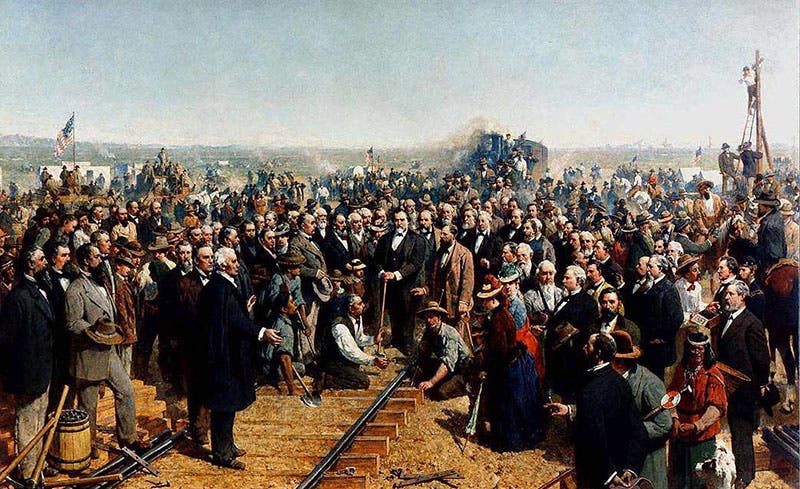Scientist of the Day - Theodore Judah
Theodore Dehone Judah, an American civil engineer, was born Mar. 4, 1826. Judah had such success building railroads in the East, such as the Niagara Gorge Railroad, that he was invited while still a young man to come to California to construct the Sacramento Valley Railroad, the first railroad west of the Mississippi. His Report of the chief engineer on the preliminary surveys, and future business of the Sacramento Valley Railroad (1854), with a map of the railroad right-of-way, is in our collections.
Immediately upon the completion of the Sacramento Valley Railroad, Judah set his sights on designing and completing a transcontinental railroad. He attracted stockholders in the form of four prominent Sacramento merchants, including Leland Stanford, who became known as the Big Four, and after making many sea voyages to Washington with crossings at Panama, Judah finally convinced Congress to pass the Pacific Railroad Act in 1862. Judah was able to be convincing because he had personally surveyed a route that could cross the Sierra Nevada at Donner Pass without exceeding a grade of 110 feet per mile, which critics had long claimed was totally impossible. It is amazing how well and how accurately Judah managed to do this with just a small crew.
However, the Big Four, who were of course in it for the money, squeezed Judah out financially, although he retained his position as Chief Engineer. Upset, Judah sailed once more for the East Coast, hoping to find someone to buy out the Big Four and restore Judah to a position of authority. On crossing the Isthmus for the umpteenth time, Judah caught yellow fever, and within days after reaching New York, on Nov. 2, 1863, he died, just 37 years old. It was just a week after the first rails for the Central Pacific were laid in Sacramento, and a week before the first Central Pacific locomotive (the Governor Stanford) made its initial run of a few hundred feet.
The Central Pacific right-of-way would be completed in 1869, with the driving of the Golden Spike by Stanford at Promontory Summit, Utah, as recorded by Thomas Hill’s famous painting, The Last Spike (1881; third image). If you would like a more accurate depiction of the ceremony, you might prefer this photograph taken on the spot by Andrew J. Russell. The route was almost precisely that which had been laid out by Judah a decade earlier. There is an excellent and more extended discussion of Judah and the Central Pacific at our Library’s online exhibition, The Transcontinental Railroad, 2012, from which one of our images was taken.
A monument to Judah stands in Sacramento (fifth image). I am not very fond of it, but others might find it appealing in some way. A much better monument would have been the fourth locomotive to be put into service on the Central Pacific: the T.D. Judah (fourth image). It is too bad that it was scrapped in 1912.
Judah’s studio portrait, however, is very nice, made in 1862, shortly before his death (first image). It is really a shame that Judah did not live to see the completion of the railroad that he envisioned and set into motion.
Dr. William B. Ashworth, Jr., Consultant for the History of Science, Linda Hall Library and Associate Professor emeritus, Department of History, University of Missouri-Kansas City. Comments or corrections are welcome; please direct to ashworthw@umkc.edu.










